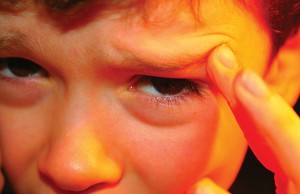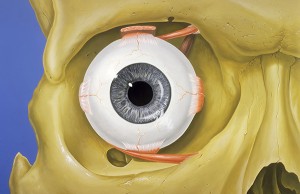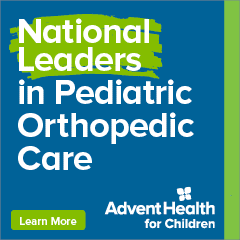August is Children’s Eye Health and Safety Month
Prior to relocating from Buffalo, New York, to practice at Nemours Children’s Hospital in Orlando, ophthalmologist Airaj F. Fasiuddin, M.D. recalls treating “one of the worst eye injuries in her professional career.” In 2010, Troy Holman, then 10, was running in a neighborhood park when he tripped and landed on a stick. The impact caused the twig to puncture Troy’s right eye. The wounded eye bled and both eyes swelled. Shakira Holman rushed her son to the hospital where Dr. Fasiuddin urgently worked to save his sight.
Troy’s serious injuries included cataracts, hyphema (blood in the eye chamber), corneal scaring, and glaucoma. “His injuries were severe. He went through a lot with multiple surgeries,” Holman said. Three years after his ocular damage, Troy wears glasses, takes a daily dose of eye drops and oral medication, and visits his new ophthalmologist often for ongoing treatment.
 According to the Coalition to Prevent Sports Eye Injuries, more than 600,000 eye injuries related to sports and recreation occur each year and 42,000 of these injuries require emergency room care. Furthermore, data from the National Eye Institute suggests that someone goes to the hospital for an eye-related injury every 13 minutes. Dr. Fasiuddin has yet to see an emergency eye injury at Nemours, which opened last fall in Lake Nona Medical City, but is quick to point out that puncture eye injuries, such as Troy’s, are “more of a freak accident” and are caused by “sharps,” such as pens, toys, and sticks. The most common eye injury, however, is caused by blunt trauma, such as direct impact from a baseball or softball, flung rubber band, or punch to the face. Another common eye injury is chemical damage, perchance from a child getting into cleaning solutions typically stored under the sink. “Parents should flush the eye as soon as possible,” Dr. Fasiuddin said. “However, parents shouldn’t mess with the eye unless there’s a chemical injury. Then, they should irrigate.”
According to the Coalition to Prevent Sports Eye Injuries, more than 600,000 eye injuries related to sports and recreation occur each year and 42,000 of these injuries require emergency room care. Furthermore, data from the National Eye Institute suggests that someone goes to the hospital for an eye-related injury every 13 minutes. Dr. Fasiuddin has yet to see an emergency eye injury at Nemours, which opened last fall in Lake Nona Medical City, but is quick to point out that puncture eye injuries, such as Troy’s, are “more of a freak accident” and are caused by “sharps,” such as pens, toys, and sticks. The most common eye injury, however, is caused by blunt trauma, such as direct impact from a baseball or softball, flung rubber band, or punch to the face. Another common eye injury is chemical damage, perchance from a child getting into cleaning solutions typically stored under the sink. “Parents should flush the eye as soon as possible,” Dr. Fasiuddin said. “However, parents shouldn’t mess with the eye unless there’s a chemical injury. Then, they should irrigate.”
Most eye injuries don’t necessarily require a trip to the hospital, but both Dr. Fasiuddin and Dr. Mark Perry, ophthalmologist at Perry Eye Center in Orlando, agree that they should be checked by a physician, including but not limited to trauma that causes a black eye. “Eye injuries are such a common thing that most pediatricians are used to treating them,” Dr. Fasiuddin stated. That was the case for Michelle Delong, who accidently scratched her son Zachary’s eye with her long fingernails in March. Her son’s Kissimmee-based pediatrician prescribed antibiotic eye drops to prevent infection.
Dr. Perry is convinced that most parents know when an eye injury is serious enough to solicit medical help; and thus, his practice offers on-call emergency hours. Despite the eye being an important organ administering a focal sense, the eye doctor is often forgotten, even during the back-to-school physical exams, unless a child complains of an issue. Eye exams aren’t required by Florida law. Nonetheless, Dr. Perry recommends children see the family ophthalmologist as early as six months old but certainly before starting preschool. “A lot of parents think the eye chart at the pediatrician’s office is a suitable eye exam,” he said. “I still see kids coming in at 8, 9, or 10-years-old that haven’t had an eye exam. Sometimes, unfortunately, parents don’t realize their child has poor vision until it becomes evident in school.”
Despite a heavy family history of vision issues, Karen Thompson, an Orlando mom, didn’t take her youngest sons, Zack and Jordan Alsieux, to an ophthalmologist until they complained about struggling to see the whiteboard in their elementary school classrooms. “They had vision screenings by their regular pediatrician but never by an eye doctor until they complained,” Thompson said, adding that both boys now wear glasses to aid with their nearsightedness. “I’m blind as a bat myself!”
 While genetics can play a role in vision problems, Dr. Perry blames (in part) society’s dependence on screen-time, including computers, smartphones, video games, and tablets; rather than outdoor recreational play which typically does not create visual stress. “Everything now is close to them. They aren’t getting outside to play baseball,” Dr. Perry affirmed. “That constant strain on the eyes harms the vision system.” While outside, however, children should wear sunglasses to protect against UV damage. Dr. Perry encourages parents to train their children to wear sunglasses whenever they’re outside, including during car rides. Infant sunglasses are available with straps that Velcro securely around the baby’s head. “Sunglasses can protect the eyes from cancer,” Dr. Perry added.
While genetics can play a role in vision problems, Dr. Perry blames (in part) society’s dependence on screen-time, including computers, smartphones, video games, and tablets; rather than outdoor recreational play which typically does not create visual stress. “Everything now is close to them. They aren’t getting outside to play baseball,” Dr. Perry affirmed. “That constant strain on the eyes harms the vision system.” While outside, however, children should wear sunglasses to protect against UV damage. Dr. Perry encourages parents to train their children to wear sunglasses whenever they’re outside, including during car rides. Infant sunglasses are available with straps that Velcro securely around the baby’s head. “Sunglasses can protect the eyes from cancer,” Dr. Perry added.
Parents should also invest in safety goggles if their children play sports. The American Academy of Ophthalmology recommends children wear sports eye protectors made with polycarbonate lenses for baseball, basketball, football, racquet sports, soccer, hockey, lacrosse, and paintball. Both Dr. Perry and Dr. Fasiuddin agree that safety goggles, while not required by youth sports programs, decrease the chances of eye injuries. “Youth can get an elbow to the eye in basketball or a finger gouge in football because the fingers slip through the facemask,” explained Dr. Perry. “In fact, there’s a potential for problems in all sports.”
Seek care by a pediatric eye doctor if your child experiences:
- Blurry vision, squinting, or rubbing of eyes
- Light sensitivity
- Eye pain/burning/itching
- Red, watery, or cloudy eyes
- One or both eyes turn in or out (lazy eye)
- Eyes unable to focus or to follow an object
- Eye(s) swollen shut
- Headaches/tiredness after up-close work









